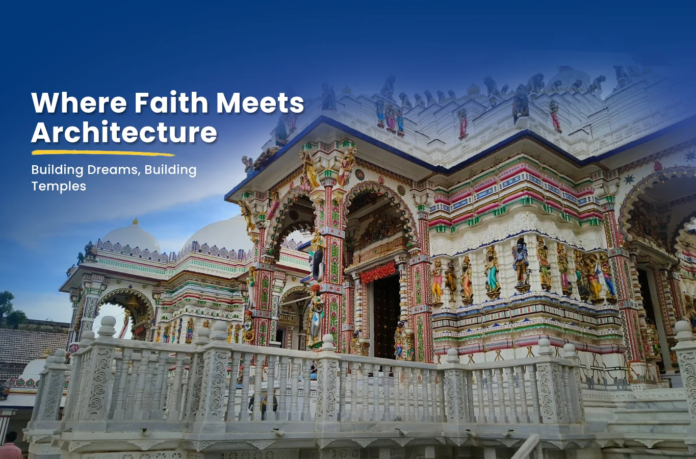Hindu temples, or mandirs, are magnificent embodiments of spirituality, culture, and architectural excellence. Over centuries, India has developed distinctive temple architectural styles, each reflecting the region’s history, beliefs, and craftsmanship. This article delves into the key architectural styles in Hindu mandir construction, emphasizing the role of Temple Architects in India , the contributions of the Jain Temple Sompura community, and the expertise offered by Temple Construction Services in Rajasthan.
The Foundation of Hindu Temple Architecture
Hindu temple architecture is deeply rooted in scriptures like Shilpa Shastra and Vaastu Shastra, which provide guidelines on design, proportions, orientation, and symbolism. These principles ensure that temples are not just physical structures but spiritual sanctuaries.
Core Elements of Hindu Temples
- Garbhagriha (Sanctum Sanctorum): The innermost chamber housing the deity.
- Shikhara/Vimana: The towering spire above the sanctum.
- Mandapa: The pillared hall for congregation and rituals.
- Pradakshina Patha: The circumambulatory path around the sanctum.
Key Architectural Styles in Hindu Mandir Construction
India’s diverse geography and culture have given rise to three primary temple architectural styles: Nagara, Dravidian, and Vesara.
1. Nagara Style: North Indian Temple Architecture
The Nagara style is prevalent in northern India and is characterized by curvilinear spires and intricate carvings.
Features
- Shikhara: A prominent, beehive-shaped tower with smaller spires around it.
- Ornamentation: Highly detailed carvings of deities, flora, and mythological scenes.
- Plan: Generally square with multiple levels leading to the sanctum.
Role of Temple Architects in India
Temple architects, especially in northern India, have mastered the art of creating Nagara-style temples that resonate with spiritual and artistic significance. They ensure precise proportions and symbolic elements in every design.
2. Dravidian Style: South Indian Temple Architecture
The Dravidian style dominates southern India and is renowned for its grand gopurams (entrance towers) and intricate sculptures.
Features
- Gopuram: Towering gateways adorned with vibrant sculptures of gods and celestial beings.
- Vimana: Pyramid-shaped sanctum spire.
- Mandapas: Spacious halls supported by intricately carved pillars.
Influence of the Jain Temple Sompura Community
While primarily associated with Jain temples, the Jain Temple Sompura community has also contributed to Dravidian-style structures by applying their unparalleled craftsmanship in carving deities and ornamental details.
3. Vesara Style: Fusion of Nagara and Dravidian
The Vesara style, prominent in central India, blends the curvilinear elegance of the Nagara style with the intricate detail of the Dravidian style.
Features
- Shikhara and Vimana: A harmonious mix of curvilinear and pyramidal designs.
- Carvings: Combines northern symbolism with southern intricacy.
- Structures: Includes both small, functional temples and sprawling complexes.
Temple Construction Services in Rajasthan
Contractors in Rajasthan specialize in constructing and restoring Vesara-style temples, utilizing local sandstone and marble to replicate the historical grandeur of these structures.
The Contributions of Temple Architects in India
Preserving Ancient Techniques
Temple architects in India draw from centuries-old scriptures and regional traditions to design temples that are both functional and spiritual.
Modern Tools for Traditional Goals
Many architects now use advanced tools like 3D modeling to ensure precision while maintaining traditional aesthetics.
The Legacy of Jain Temple Sompura Artisans
Masters of Marble and Intricate Carvings
The Jain Temple Sompura community is renowned for its expertise in creating ornate Jain and Hindu temples. Their hallmark is the use of finely carved marble, often depicting scenes from mythology.
Collaboration in Hindu Mandir Projects
Sompura artisans frequently collaborate with temple architects and contractors to bring their vision to life, ensuring every detail aligns with spiritual and artistic expectations.
Rajasthan: A Hub for Temple Construction Services
Specialized Services in Temple Construction
Rajasthan is known for its robust Temple Construction Services, including:
- Design and Planning: Firms provide expert guidance for architectural layouts.
- Stone Carving: Rajasthan’s artisans specialize in working with marble and sandstone, essential for traditional temple construction.
- Restoration Projects: The state is a leader in preserving and restoring ancient temples.
Why Rajasthan Excels in Temple Construction
The abundance of skilled artisans, combined with high-quality natural materials and a cultural heritage rooted in temple architecture, makes Rajasthan a preferred choice for mandir projects.
Challenges in Maintaining Architectural Styles
Balancing Tradition and Innovation
While traditional styles demand authenticity, incorporating modern construction methods can improve efficiency without compromising cultural values.
Sourcing Authentic Materials
High-quality materials like marble and granite are essential for temple construction but can be costly and logistically challenging to source.
Adherence to Spiritual Guidelines
Ensuring compliance with Vaastu Shastra and Shilpa Shastra while accommodating modern needs requires meticulous planning.
The Future of Temple Architecture
As interest in preserving cultural heritage grows, temple construction is experiencing a revival. Collaboration between Temple Architects in India, artisans from the Jain Temple Sompura community, and experts in Temple Construction Services in Rajasthan ensures that traditional styles remain vibrant and relevant.
Conclusion
Hindu mandir construction is an art form that embodies India’s spiritual and cultural legacy. From the towering gopurams of the Dravidian style to the intricate carvings of Nagara temples and the harmonious Vesara designs, each style reflects the region’s rich history and beliefs.
The combined efforts of Temple Architects in India, the skilled craftsmanship of the Jain Temple Sompura artisans, and the expertise of Temple Construction Services in Rajasthan ensure that these sacred structures continue to inspire awe and devotion for generations. By honoring ancient traditions while embracing modern innovations, Hindu temple architecture remains a timeless testament to India’s spiritual heritage.


